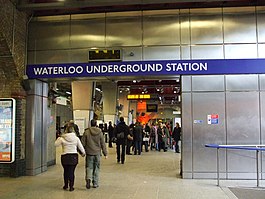Waterloo tube station
| Waterloo | |
|---|---|
 Entrance to Jubilee line from Waterloo main line station | |
| Location | South Bank |
| Local authority | London Borough of Lambeth |
| Managed by | London Underground |
| Owner | London Underground |
| Number of platforms | 8 |
| Accessible | Yes(Jubilee line only)[1] |
| Fare zone | 1 |
| OSI | Waterloo NR Waterloo East[2] |
| London Underground annual entry and exit | |
| 2019 | |
| 2020 | |
| 2021 | |
| 2022 | |
| 2023 | |
| Key dates | |
| 1898 | W&CR opened station |
| 1906 | BS&WR started |
| 1926 | CCH&R started |
| 1999 | Jubilee line started |
| Other information | |
| External links | |
Waterloo tube station is a London Underground station located within the Waterloo station complex that incorporates both the tube station and the mainline railway station. It is the busiest station on the Underground network[8] with over 88 million passenger entries and exits in 2012, and it is served by four lines: the Bakerloo, Jubilee, Northern and Waterloo & City lines.
The station is situated in fare zone 1 and is located near the South Bank of the River Thames, in the London Borough of Lambeth.
History
The first Underground station at Waterloo was opened on 8 August 1898 by the Waterloo & City Railway (W&CR), a subsidiary of the owners of the main line station, the London and South Western Railway (L&SWR).[9] The W&CR, nicknamed "The Drain",[10] achieved in a limited way the L&SWR's original plan of taking its tracks the short distance north-east into the City of London.
On 10 March 1906, the Baker Street & Waterloo Railway (BS&WR, now the Bakerloo line) was opened.[9] On 13 September 1926, the extension of the Hampstead & Highgate line (as the Charing Cross branch of the Northern line was then known) was opened from Embankment to the existing City & South London Railway station Kennington with a new station at Waterloo.[9]
As a subsidiary of the L&SWR and its successor, the Southern Railway, the W&CR was not a part of the London Underground system. Following nationalisation of the main line railway companies in 1948, it became part of British Railways (later British Rail). Following a period of closure during 1993 when the line was converted to use the four rail electrical system of the London Underground, the ownership of the Waterloo & City line was transferred to the Underground on 1 April 1994.[11] Due to an Easter shut-down, the first Underground service on the line was on 5 April 1994.[9]
On 24 September 1999, the Jubilee line station was opened as part of the Jubilee Line Extension.[9] The station was temporarily the western terminus of the extension running from Stratford in east London, before the final section to link the extension to the original line was opened between Waterloo and Green Park on 20 November 1999.[9] The Jubilee line platforms are at the opposite end of the site from those of the Bakerloo and Northern lines, but the two ends are connected by a 140-metre (460 ft) moving walkway link (one of only two on the Underground; the other gives access to the Waterloo & City line platform at Bank station).
Today the station is served by London Buses routes 1, 4, 26, 59, 68, 76, 77, 139, 168, 171, 172, 176, 188, 211, 243, 341, 381, 507, 521, RV1, X68 and night bus routes N1, N68, N76, N171, N343 and N381.
Gallery
-
Northern line northbound platform looking south
-
Jubilee line westbound platform looking east
-
Travelator between Jubilee and Bakerloo/Northern line platforms
References
- ^ "Step free Tube Guide" (PDF). Transport for London. April 2021. Archived (PDF) from the original on 15 May 2021.
- ^ "Out of Station Interchanges" (XLSX). Transport for London. 16 June 2020. Retrieved 5 November 2020.
- ^ "Station Usage Data" (XLSX). Usage Statistics for London Stations, 2019. Transport for London. 23 September 2020. Archived from the original on 9 November 2020. Retrieved 9 November 2020.
- ^ "Station Usage Data" (XLSX). Usage Statistics for London Stations, 2020. Transport for London. 16 April 2021. Retrieved 1 January 2022.
- ^ "Station Usage Data" (XLSX). Usage Statistics for London Stations, 2021. Transport for London. 12 July 2022. Retrieved 7 September 2022.
- ^ "Station Usage Data" (XLSX). Usage Statistics for London Stations, 2022. Transport for London. 4 October 2023. Retrieved 10 October 2023.
- ^ "Station Usage Data" (XLSX). Usage Statistics for London Stations, 2023. Transport for London. 8 August 2024. Retrieved 16 September 2024.
- ^ http://www.tfl.gov.uk/tfl/corporate/modesoftransport/tube/performance/default.asp?onload=entryexit
- ^ a b c d e f Rose, Douglas (1999). The London Underground, A Diagrammatic History. Douglas Rose/Capital Transport. ISBN 1-85414-219-4.
- ^ Wolmar, Christian (2004). "Deep Under London". The Subterranean Railway: How the London Underground Was Built and How It Changed the City Forever. Atlantic Books. p. 146. ISBN 1-84354-023-1.
- ^ "Waterloo & City line, Dates". Clive's Underground Line Guides. Retrieved 20 July 2008.
External links
| Preceding station | Following station | |||
|---|---|---|---|---|
toward Template:LUL stations | Template:LUL lines | toward Template:LUL stations |
||
toward Template:LUL stations | Template:LUL lines | toward Template:LUL stations |
||
toward Template:LUL stations | Template:LUL lines Charing Cross branch | toward Template:LUL stations |
||
| Terminus | Template:LUL lines | toward Template:LUL stations |
- Use dmy dates from August 2012
- Rail transport stations in London fare zone 1
- Bakerloo Line stations
- Northern Line stations
- Jubilee Line stations
- Waterloo & City Line stations
- Tube stations in Lambeth
- Railway stations opened in 1898
- Former Baker Street and Waterloo Railway stations
- Railway stations opened in 1906



